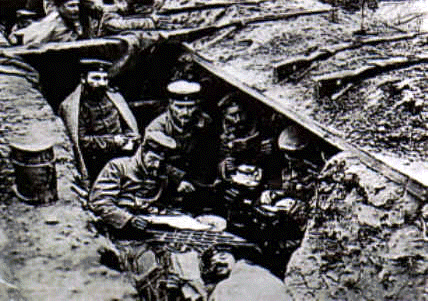WWI - Timeline
- Post 1914
- The situation in Europe
- 1914
- June 28: Franz Ferdinand assassinated in Sarajevo
- The Great War breaks out
- August 23: Germany invades France
- The British Blockade
- 1915
- The "Lusitania" was sunk by a German U-boat
- April: Italy joins the war
- War in the trenches
- London attacked from the air by German Zeppelins
- 1916
- Battle of Verdun
- Battle of Jutland
- Battle of the Somme
- 1917
- Germany's unrestricted u-boat warfare
- The USA joins the war
- Russia leavs the War
- 1918
- Germany's last offensive
- The Battle of the Argonne Forest
- The First World War ends
- Treaty of Versailles
War in the trenches
During the First World War a great part of the battles were fought from trenches. Especially on the western front the troops dug down into a network of trenches that stretched from the English Channel to the Swiss border, the space between the trenches were known as the "no man's land". The tactics to break through the enemy line were often to start with massive artillery barrages followed by soldiers scrambling out of their trenches and ran over the "no man's land" and threw grenades into the enemy trenches. This was a very bad tactic; it only led to limited success at a great cost of lives, so both sides started to look into new technology to break through enemy lines.

In April 1915 the Germans brought a new element to the war in the trenches. In the Second Battle of Ypres they used poison gas. The Allies didn't wait long before they started doing the same weapon. The gas caused vomiting, blindness and suffocation. Gas masks became a standard part of a soldier's equipment. Britain brought the tank into the battle in 1916. At the beginning the tanks were slow and fairly easy to destroy, but they soon got better and became a important part of the battlefield.